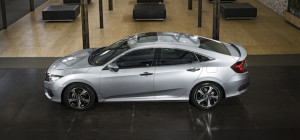
 At the end of June, the New Zealand Transport Agency (NZTA) had registered 1865 new Honda vehicles, an average for the carmaker of 310 a month for the first six months of 2016.
At the end of June, the New Zealand Transport Agency (NZTA) had registered 1865 new Honda vehicles, an average for the carmaker of 310 a month for the first six months of 2016.
The total was made up as follows: Jazz 830, HRV 611, CRV 260, Civic range 83, Odyssey 47, others 34. The small Jazz hatchback and medium CRV and compact HRV crossover/SUVs therefore accounted for 1701 units, or an overwhelming 91 per cent of Honda NZ registrations.
HRV and CRV together nudged 47 per cent, or almost five out of every 10 new Hondas on the NZTA books. Jazz alone accounted for 44.5 per cent. The Civic, on the other hand, did a paltry 4.4 per cent of business.
Okay, it was the old model, on run-out pretty much since last year. But it could be argued that Honda is trying to lasso the wind with its sales targets for the new Civic sedan.
 “It’s a challenging market and there’s a trend away from sedans,” said Honda NZ marketing manager Nadine Bell. “But we want to bring buyers back into a sedan. That’s our aim … we’ll see.”
“It’s a challenging market and there’s a trend away from sedans,” said Honda NZ marketing manager Nadine Bell. “But we want to bring buyers back into a sedan. That’s our aim … we’ll see.”
Honda wants to sell 600 Civic sedans by next March 31, the end of the 2016-17 financial year. That’s an average of 75 a month over the next eight. Bell said the other day it had already received over 50 orders for the car from the Honda faithful. “We will get hatchback buyers into the sedan,” she said.
But will existing Civic hatchback owners prefer to wait until the first half of next year for the new hatchback? It sits on the same platform as the sedan and will have the same four-cylinder engine line-up, a naturally aspirated 1.8-litre unit or a turbocharged 1.5-litre.
 It’s a poser for Honda and the tenth-generation Civic range, described by Honda NZ managing director Nobuya Sonoda as the most important model in the carmaker’s history. “We’re confident the customers who have been looking for the original sporty DNA that Honda was founded on are going to find it in this new Civic,” he said.
It’s a poser for Honda and the tenth-generation Civic range, described by Honda NZ managing director Nobuya Sonoda as the most important model in the carmaker’s history. “We’re confident the customers who have been looking for the original sporty DNA that Honda was founded on are going to find it in this new Civic,” he said.
The four-door is a good looker, its lower, wider and longer proportions showing a hint here and there of styling cues from the NSX supercar. From the outside it’s a small sedan/liftback. But on the inside it just might be the biggest small sedan on the market, despite an initial feeling at the wheel of a closed-in cockpit.
The layout of the instrument cluster is clever and the driver’s seat provides a good view of the road, thanks also to the windscreen’s slimmer A-pillars. Room in the rear is especially good. So too the 519-litre boot. Clearly, Honda’s interior design people have applied the packaging science from the Jazz hatchback.
 There are four Civic variants, each using a continuously variable transmission (CVT). Standard equipment includes USB ports, 12-volt sockets, and an 18cm touchscreen display offering a range of applications, including a reversing camera and Apple CarPlay and Android Auto.
There are four Civic variants, each using a continuously variable transmission (CVT). Standard equipment includes USB ports, 12-volt sockets, and an 18cm touchscreen display offering a range of applications, including a reversing camera and Apple CarPlay and Android Auto.
The entry-level Civic S ($29,900) is made in Thailand, rides on 16-inch alloys, and uses the 104kW/174Nm 1.8-litre engine. The remaining three are out of Japan and come with 17-inch wheels and the boosted 127kW/220Nm 1.5-litre unit. There’s the Civic Turbo ($35,500), Civic RS Turbo ($39,900) and Civic NT Turbo ($42,900).
Additional equipment like leather trim, powered seats, intelligent headlights, live traffic updates, collision warning and lane departure sensors, adaptive cruise control and other electronic safety aids are commensurate with the jumps in price.
 Honda launched Civic on the smooth blacktop of the Hampton Downs circuit. It did so to emphasise the car’s minimal body roll through the track’s demanding corners and the good feedback from its quicker steering ratio through a temporary slalom. A few days on highways and suburban streets will better indicate ride quality.
Honda launched Civic on the smooth blacktop of the Hampton Downs circuit. It did so to emphasise the car’s minimal body roll through the track’s demanding corners and the good feedback from its quicker steering ratio through a temporary slalom. A few days on highways and suburban streets will better indicate ride quality.
The marriage between the 1.5-litre engine and the seven-step CVT in the RS, for example, is especially pleasing, with or without the use of the steering wheel-mounted paddles. Not that the coupling with the 1.8-litre unit in the entry-level Civic S misses the mark – it might not be as responsive but the car itself is an excellent package at the price.
It’s just that the boosted 1.5-litre unit belongs to the same family as one of Honda’s standout engines, the 2.0-litre 228kW/400Nm firecracker in the Civic Type R hatchback. The extra oomph adds a dynamic dimension to the sedan that isn’t obvious in the 1.8-litre example. Now all Honda NZ has to do is reignite interest in the famous nameplate.
